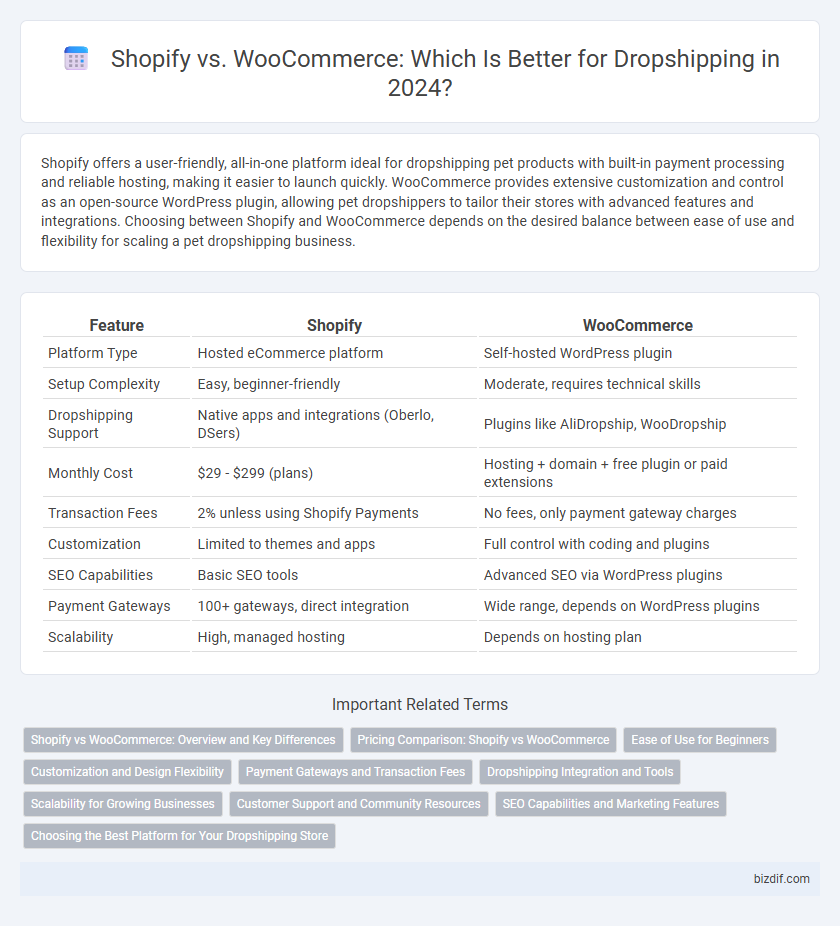Shopify offers a user-friendly, all-in-one platform ideal for dropshipping pet products with built-in payment processing and reliable hosting, making it easier to launch quickly. WooCommerce provides extensive customization and control as an open-source WordPress plugin, allowing pet dropshippers to tailor their stores with advanced features and integrations. Choosing between Shopify and WooCommerce depends on the desired balance between ease of use and flexibility for scaling a pet dropshipping business.
Table of Comparison
| Feature | Shopify | WooCommerce |
|---|---|---|
| Platform Type | Hosted eCommerce platform | Self-hosted WordPress plugin |
| Setup Complexity | Easy, beginner-friendly | Moderate, requires technical skills |
| Dropshipping Support | Native apps and integrations (Oberlo, DSers) | Plugins like AliDropship, WooDropship |
| Monthly Cost | $29 - $299 (plans) | Hosting + domain + free plugin or paid extensions |
| Transaction Fees | 2% unless using Shopify Payments | No fees, only payment gateway charges |
| Customization | Limited to themes and apps | Full control with coding and plugins |
| SEO Capabilities | Basic SEO tools | Advanced SEO via WordPress plugins |
| Payment Gateways | 100+ gateways, direct integration | Wide range, depends on WordPress plugins |
| Scalability | High, managed hosting | Depends on hosting plan |
Shopify vs WooCommerce: Overview and Key Differences
Shopify offers a fully hosted ecommerce platform ideal for beginners, featuring built-in payment processing, marketing tools, and 24/7 support, while WooCommerce operates as a WordPress plugin requiring separate hosting, offering greater customization and control. Shopify's scalable infrastructure and automated updates provide hassle-free maintenance, whereas WooCommerce demands manual updates and technical knowledge for optimal performance. Pricing differs significantly, with Shopify charging monthly subscription fees and transaction fees, contrasting WooCommerce's lower base cost but additional expenses for hosting, security, and premium extensions.
Pricing Comparison: Shopify vs WooCommerce
Shopify offers a tiered pricing structure ranging from $29 to $299 per month, including hosting, security, and customer support, making it a convenient all-in-one solution for dropshipping businesses. WooCommerce is a free plugin for WordPress, but costs can arise from hosting, domain registration, security, and premium extensions, which vary widely depending on the provider and add-ons chosen. For dropshippers seeking a scalable platform with predictable monthly fees, Shopify provides clearer pricing, while WooCommerce offers more flexibility and potentially lower upfront costs but requires more hands-on management.
Ease of Use for Beginners
Shopify offers a user-friendly interface with a straightforward setup process, ideal for beginners seeking quick store launch without technical hurdles. WooCommerce requires more technical knowledge, including WordPress familiarity and plugin management, making it less intuitive for newcomers. Beginners prioritize Shopify for its all-in-one platform, including hosting, security, and built-in payment processing, which simplifies dropshipping operations.
Customization and Design Flexibility
Shopify offers a wide array of professionally designed themes with limited customization options aimed at ease of use, making it ideal for beginners in dropshipping. WooCommerce provides extensive design flexibility through open-source access, allowing advanced users to fully customize their store's appearance and functionality using plugins and code. For dropshippers prioritizing unique branding and tailored user experience, WooCommerce delivers superior customization compared to Shopify's more streamlined design framework.
Payment Gateways and Transaction Fees
Shopify offers a wide range of integrated payment gateways, including its own Shopify Payments, which eliminates transaction fees on orders, while third-party gateways incur fees ranging from 0.5% to 2%. WooCommerce supports numerous payment gateways through plugins, with no additional transaction fees from WooCommerce itself, but merchants must pay gateway-specific fees such as Stripe's 2.9% + 30C/ per transaction. Choosing between Shopify and WooCommerce depends on balancing built-in convenience and transparent fee structures against customization flexibility and external payment provider costs in dropshipping businesses.
Dropshipping Integration and Tools
Shopify offers seamless dropshipping integration through its extensive app store, including popular tools like Oberlo and Spocket, enabling automated product import, order fulfillment, and inventory management. WooCommerce, built on WordPress, provides customizable dropshipping plugins such as AliDropship and WooDropship, offering flexible sourcing and automation solutions but requiring more technical setup. Both platforms support scalable dropshipping businesses, with Shopify excelling in ease of use and WooCommerce delivering greater control over customization and cost efficiency.
Scalability for Growing Businesses
Shopify offers seamless scalability with robust server infrastructure, handling high traffic and large order volumes without performance issues, making it ideal for growing dropshipping businesses. WooCommerce, while highly customizable, depends on external hosting and requires technical expertise to scale effectively, which can pose challenges as store demands increase. Shopify's integrated features and automated updates simplify growth management, whereas WooCommerce provides more flexibility but demands greater hands-on optimization for scalability.
Customer Support and Community Resources
Shopify offers 24/7 customer support through live chat, email, and phone, ensuring quick resolution for dropshipping store owners. WooCommerce relies heavily on community forums, extensive documentation, and third-party support due to its open-source nature, which can lead to varied response times. For dropshippers seeking consistent, dedicated support, Shopify provides a more reliable option, while WooCommerce excels with a robust, active community sharing in-depth resources.
SEO Capabilities and Marketing Features
Shopify offers robust built-in SEO capabilities with customizable meta tags, fast loading speeds, and automatic sitemap generation, making it ideal for users seeking a streamlined setup. WooCommerce, integrated with WordPress, provides superior flexibility for advanced SEO through plugins like Yoast SEO and extensive marketing features tailored for content-rich strategies. Both platforms enable effective dropshipping operations, but WooCommerce excels in customizable SEO tools, while Shopify prioritizes ease of use and integrated marketing apps.
Choosing the Best Platform for Your Dropshipping Store
Shopify offers an all-in-one, user-friendly platform with seamless dropshipping integrations, making it ideal for beginners looking for quick store setup and reliable hosting. WooCommerce, a WordPress plugin, provides greater customization and control over e-commerce features, appealing to experienced users seeking flexibility and lower ongoing costs. Evaluating factors such as budget, design preferences, scalability, and technical skills is essential when choosing the best platform for your dropshipping store.
Shopify vs WooCommerce Infographic

 bizdif.com
bizdif.com